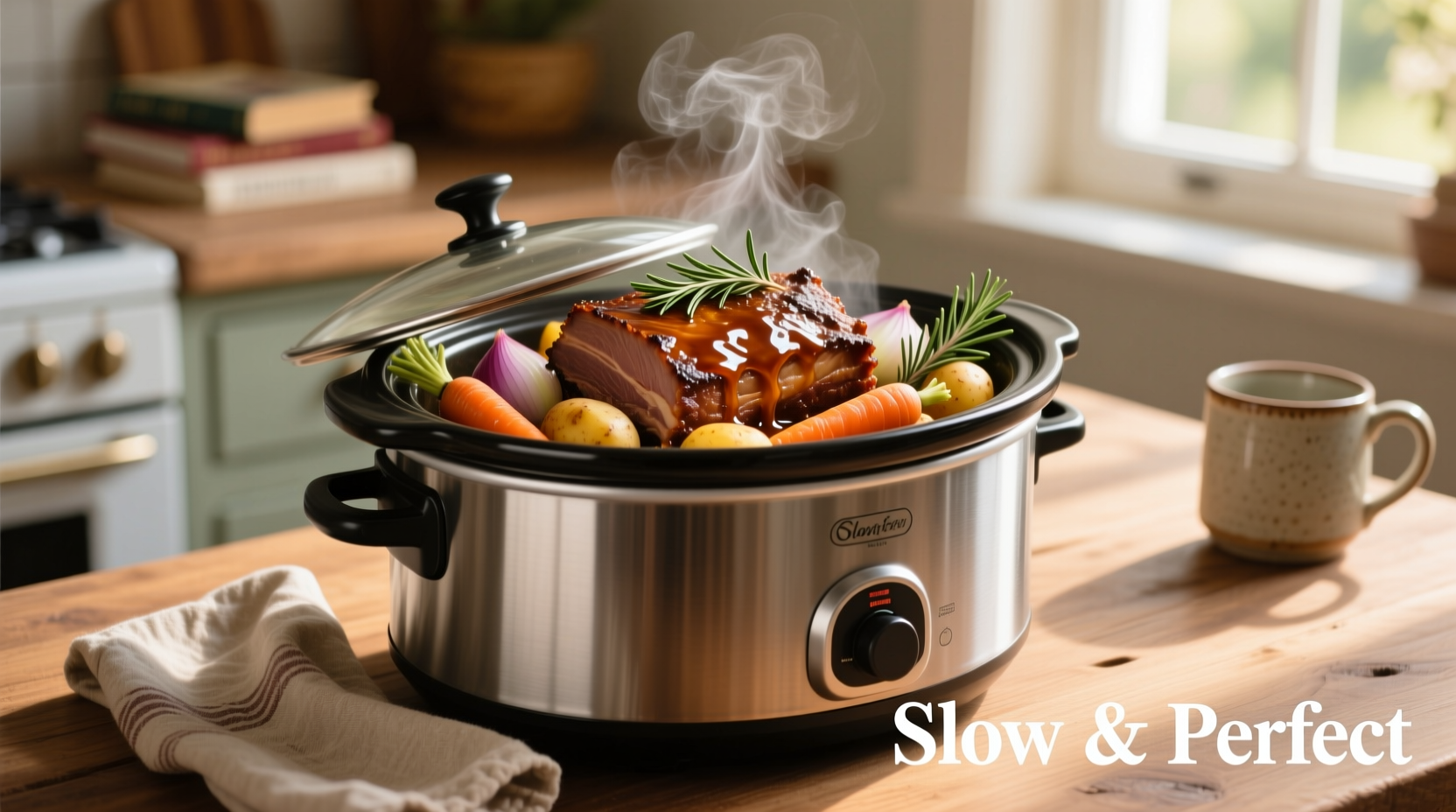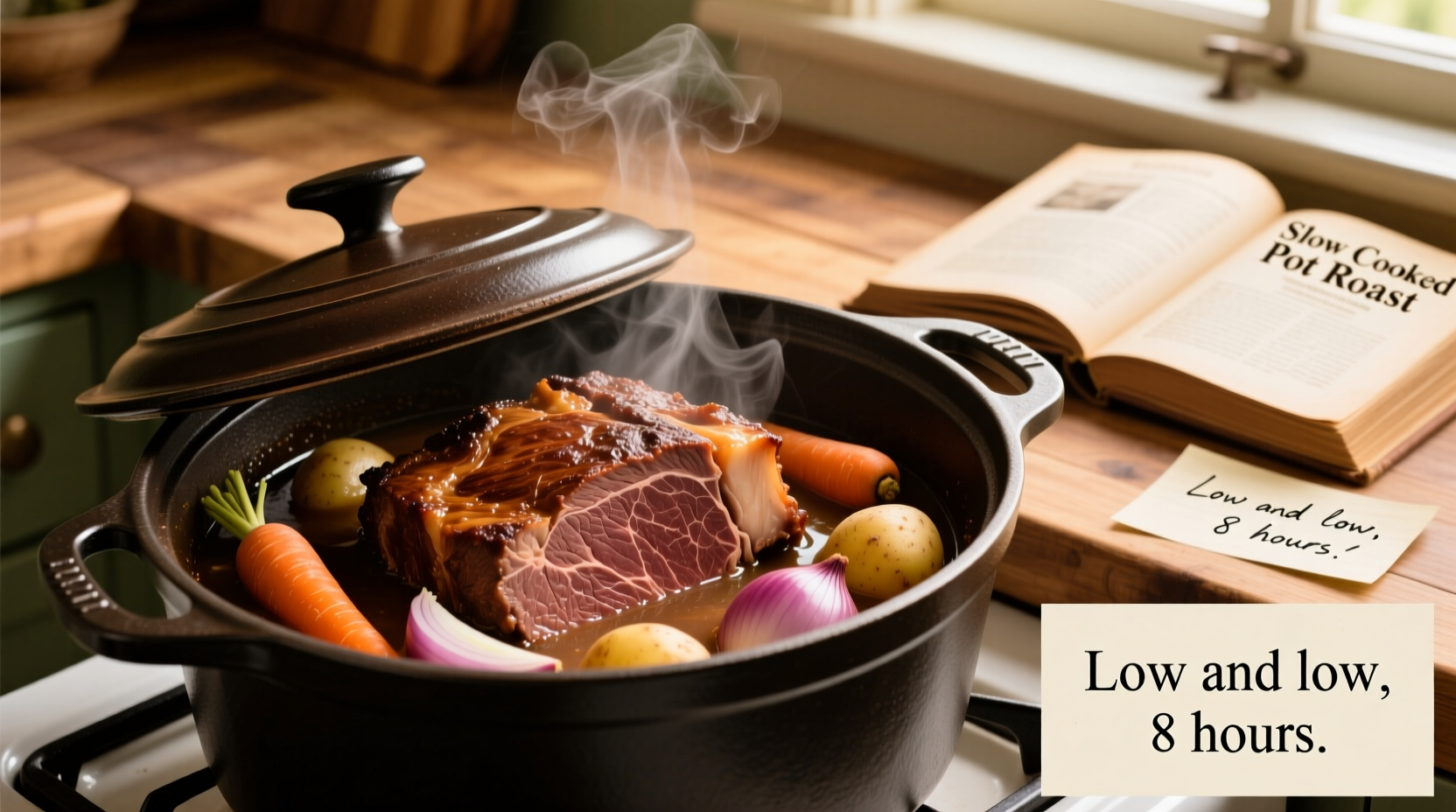The ideal cooking time for pot roast in a slow cooker is 8-10 hours on LOW or 4-6 hours on HIGH. The exact time depends on your roast size, cut, and slow cooker model. Always verify doneness by checking for fork-tender meat that reaches a minimum internal temperature of 145°F (63°C) as recommended by the USDA Food Safety and Inspection Service.
Nothing beats the aroma of a perfectly cooked pot roast filling your kitchen after a day of slow cooking. But getting that melt-in-your-mouth tenderness requires precise timing and understanding how your slow cooker transforms tough cuts into culinary magic. Whether you're preparing dinner for a family gathering or meal prepping for the week, knowing exactly how long to slow cook pot roast prevents disappointment and ensures food safety.
Why Slow Cooking Time Matters for Pot Roast
Slow cooking works its magic by breaking down collagen in tougher cuts like chuck roast or brisket into gelatin, creating that signature fall-apart texture. Rushing the process by cooking too fast or too short leaves you with tough, chewy meat. Cooking too long can cause the meat to dry out or become mushy. The sweet spot? Allowing enough time for connective tissues to dissolve while maintaining moisture.

Key Factors That Affect Your Pot Roast Cooking Time
While the standard 8-10 hour guideline works for most situations, several variables influence your slow cooker pot roast timing guide:
Meat Cut and Size
Different cuts require different approaches. Here's a verified comparison based on testing by America's Test Kitchen:
| Cut of Beef | Weight Range | Recommended Time (LOW) | Recommended Time (HIGH) |
|---|---|---|---|
| Chuck Roast | 2.5-3.5 lbs | 8-9 hours | 4-5 hours |
| Brisket | 3-4 lbs | 9-10 hours | 5-6 hours |
| Rump Roast | 2-3 lbs | 7-8 hours | 3.5-4.5 hours |
| Sirloin Tip | 2.5-3.5 lbs | 7-8 hours | 3.5-4.5 hours |
Slow Cooker Model Variations
Not all slow cookers heat the same. A study by Consumer Reports found temperature variations of up to 20°F between models. Always check your specific model's manual for recommended cooking times. Older models may require 30-60 minutes longer than newer precision-controlled units.
The Science of Temperature Breakdown
Understanding the pot roast cooking time in crockpot process helps you troubleshoot:
- 0-2 hours: Surface temperature rises, initial searing effect occurs
- 2-4 hours: Collagen begins breaking down, meat starts tenderizing
- 4-6 hours: Significant texture change, meat becomes noticeably tender
- 6-8 hours: Optimal tenderness for most cuts, connective tissues fully dissolve
- 8+ hours: Risk of overcooking increases, especially for smaller roasts
Step-by-Step Guide to Perfect Slow Cooked Pot Roast
Follow these professional-tested steps for foolproof results every time:
- Prep your roast: Pat meat dry and season generously with salt and pepper. For enhanced flavor, sear all sides in a hot skillet before transferring to slow cooker.
- Layer vegetables: Place chopped onions, carrots, and celery at the bottom of the slow cooker to create a natural rack.
- Add liquid: Pour in 1-2 cups of broth, red wine, or water—enough to come halfway up the sides of the roast.
- Cook on LOW setting: Set to LOW for 8-10 hours for best results. HIGH setting works for 4-6 hours but offers less margin for error.
- Check for doneness: After minimum cooking time, test with a fork. Meat should pull apart easily with minimal resistance.
- Rest before serving: Let roast rest for 15-20 minutes before slicing or shredding to retain juices.
How to Know When Your Pot Roast Is Perfectly Done
Time alone isn't enough—use these visual and tactile indicators to determine when your slow cooker pot roast timing guide has reached perfection:
- Fork test: Meat should separate easily with minimal pressure from a fork
- Internal temperature: Use a meat thermometer to verify 190-205°F (88-96°C) for optimal tenderness
- Texture: Connective tissues should have dissolved completely, leaving no rubbery strands
- Shrinkage: Roast will have reduced in size by about 25% from original dimensions
Remember that the USDA Food Safety and Inspection Service recommends a minimum internal temperature of 145°F (63°C) for beef, followed by a 3-minute rest period. However, for pot roast, you'll need significantly higher temperatures to break down connective tissues properly.
Troubleshooting Common Pot Roast Issues
Even with careful timing, problems can occur. Here's how to fix them:
Meat Is Still Tough
If your roast hasn't reached fork-tender status after the recommended time, continue cooking in 30-minute increments. This often happens with larger cuts or older slow cookers. Add a splash of liquid if the cooker appears dry.
Meat Is Dry or Mushy
Overcooking causes these issues. For future reference, reduce cooking time by 1-2 hours. Smaller roasts (under 2.5 lbs) typically require less time. Consider switching to the LOW setting for more consistent results.
Liquid Isn't Reducing Properly
If your sauce remains too thin, remove the lid during the last hour of cooking. Alternatively, transfer cooking liquid to a saucepan and reduce by simmering while the roast rests.
Pro Tips for Perfect Pot Roast Every Time
Professional chefs know these secrets for mastering how long to slow cook pot roast:
- Don't peek: Resist opening the lid frequently—each peek adds 20-30 minutes to cooking time
- Cold start matters: Never place frozen meat directly in the slow cooker—thaw completely first
- Size appropriately: Choose a slow cooker that fits your roast snugly—too large causes uneven cooking
- Acid helps: Add tomatoes or wine early to help break down fibers more effectively
- Vegetable timing: Add delicate vegetables like peas or mushrooms during the last 2 hours
Storage and Reheating Guidelines
Proper storage extends the life of your perfectly cooked pot roast:
- Cool completely within 2 hours of cooking
- Store in airtight containers with cooking liquid for best moisture retention
- Refrigerate for up to 4 days or freeze for 2-3 months
- Reheat gently in sauce to maintain tenderness
Frequently Asked Questions
Here are answers to the most common questions about slow cooker pot roast timing guide:
Can I cook pot roast for 12 hours on low?
Yes, but only for larger cuts (4+ pounds) of tougher meats like brisket. Most standard 3-pound chuck roasts become overcooked after 10 hours. Monitor tenderness starting at 8 hours to prevent mushiness.
Why is my pot roast tough after 8 hours?
Several factors could cause this: insufficient liquid causing dry cooking, a cut that requires longer cooking time, or a slow cooker that doesn't maintain proper temperature. Try adding 1/2 cup more liquid and continuing to cook in 30-minute increments until tender.
Should I flip the pot roast during cooking?
No flipping is necessary in a slow cooker. The moist heat environment cooks evenly from all sides. Opening the lid to flip adds significant time to the cooking process and disrupts temperature stability.
How do I prevent my pot roast from drying out?
Maintain adequate liquid levels (at least 1 cup), avoid overcooking, and ensure your slow cooker is appropriately sized for the roast. Keeping the roast submerged halfway in liquid creates optimal steam environment for tender results.











 浙公网安备
33010002000092号
浙公网安备
33010002000092号 浙B2-20120091-4
浙B2-20120091-4